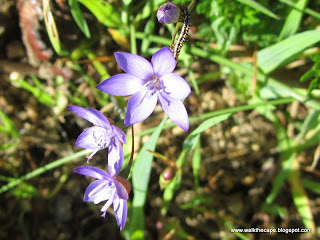 Date:
Date: 25 September 2010
Location: Lion's HeadWalkers: Michele & Helen
I've walked here before! Have a look at the Lion's Head archive,
here.

Our plan was to walk up Lion's Head, but take it really slow and look for spring flowers. And we were not disappointed.... there was an
astonishing number of plants in flower. So exciting!
Near the start we saw
Muraltia heisteria,
Lobostemon (
glaucophyllus, the common one, I think),
Romulea rosea and
Vicia benghalensis. This last one is a naturalised alien, not an indigenous plant, even though it looks a little like
Lessertia.
Research on the
net helped me make an identification.




Pretty
Pelargonium lobatum and tiny
Hermannia (not sure which one).


It was a gorgeous afternoon and the views were fabulous!


The walk is a steady up, circling to the top. But we were looking down.

We saw masses of the delicate blue
satinflower, Geissorhiza aspera.




And also beautiful
star lily, Spiloxene. As far as I know the white one is
Spiloxine aquatica and the one with the blue/black centre
Spiloxene capensis, the peacock flower. Isn't it magnificent?




The common rose-scented
Pelagonium capitatum was just coming into flower. We'll see these pink flowers well into the summer months.

We also saw another
pelargonium, a variety that I hadn't seen before. I think I've correctly identified it as
Pelargonium hirtum. It is only found on Lion's Head and above Camps Bay. What a sweet little flower.
 Aspalanthus cordata
Aspalanthus cordata,
Europys pectinatus,
Athanasia crithmifolia, and a little
yellow Morea. There are so many different yellow varieties of Morea, I don't know how to begin telling them apart.




We followed the path along to the sunny west-facing slope. More flowers!

 Wachendorfia paniculata
Wachendorfia paniculata.

Indigenous sages, both the brown one
Salvia africana-
lutea, and the blue one
Salvia africana-
caerulea.

 Adenandra uniflora
Adenandra uniflora, Erica
baccans,
Sutherlandia frutescens and
Crassula fascicularis. These four were the easiest to identify as they're so distinctive.



 Ornithogalum flaccida
Ornithogalum flaccida, common name Soldier-in-the-box. Cute!

 Oxalis obtusa,
Oxalis obtusa, nestling amongst the rocks, enjoying the sunshine.

 Lachenalia
Lachenalia. Not sure if this one is
fistulosa or
orchioides; I think the latter.

For the first time we took a little path up to the right, to the higher paragliding launching place, just out of view from the main path.




From here there was a vertigo-inducing view down to Clifton below.

On this slope we saw lots of happy Trachyandra.

And also Dischisma ciliatum. Lots of it!

We didn't only see flowers... also grasses, dandelions and seed pods.




And then we saw the beautiful Babiana! It was everywhere. Love it.



As we looked closely at most flowers we saw lots of tiny insects.


After re-joining the main path we walked on, until back around to the east-facing slope, and continued up the ladders and rocks, and along the recommended route to the front of the mountain.




Zantedeschia aethiopica. More commonly known as the arum lily.

Chasmanthe floribunda, the cobra lily.


The creeper Cyphia volubilis. Love this one!

And another star lily, Spiloxene alba.Witsterretjie.



We also saw Ornitholgalum thyrsoides (commonly known as the Chink), Silene undulata, Oftia africana, and Coleonema album.




The sun was getting low as we climbed up to the plateau, so we didn't go all the way up. After a wee rest and snack, turned round and retraced our steps, down as darkness fell.


.









































































